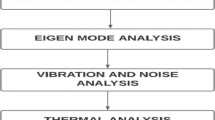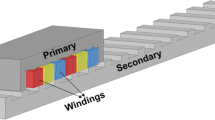Abstract
Due to high precision, high speed, and high fault tolerance capability, the linear switched reluctance motor (LSRM) is applied in digital control technologies as well as electronic switching devices. The LSRM is considered as a good substitute for conventional linear drive systems for long-way transportation. In this paper, a single-stator and double-stator longitudinal flux-type LSRM for high-speed transit system is proposed. Since the flux in the longitudinal arrangement is in the same alignment as the motion of the translator, the proposed system is easier to construct, mechanically stable with minimum eddy current loss. It also produces the magnetic flux along the direction of motion, which makes it highly suitable for high-speed linear transit application. The proposed conceptual LSRM differs from the conventional LSRM, in such a way that the active stator holds the excitation windings, while at the same time it acts as a translational body that moves over the stationary translator bed. The motor characterization is performed in ANSYS electromagnetic simulation tool, to determine the applied forces, coupling inductance, and strength of the magnetic field of the proposed LSRM for the traction propulsion system. The finite element analysis (FEA) is utilized here to analyze the modeled configuration, for verification of the design and performance prediction of the proposed LSRM.













Similar content being viewed by others
Data availability
Data sharing is not applicable to this article as no new data were created or analyzed in this study.
Code availability
Not applicable.
References
Vatani M, Mirsalim M (2020) The modular and crooked-tooth translator linear switched reluctance motor with a high-thrust per weight. IEEE Trans Transp Elect. https://doi.org/10.1109/TTE.2020.3047516
Cao R, Su E, Lu M (2020) Comparative study of permanent magnet assisted linear switched reluctance motor and linear flux switching permanent magnet motor for railway transportation. IEEE Trans Appl Supercond 30(4):1–5
Li X, Wang X, Yu S (2020) Design and analysis of a novel transverse-flux tubular linear switched reluctance machine for minimizing force ripple. IEEE Trans Transp Elect 7(2):741–753
Masoudi S, Mehrjerdi H, Ghorbani A (2020) Adaptive control strategy for velocity control of a linear switched reluctance motor. IET Electr Power Appl 14(8):1496–1503
Frank M, Drikakis D, Charissis V (2020) Machine-learning methods for computational science and engineering. Computation 8(1):15
Sundararaj V, Anoop V, Dixit P, Arjaria A, Chourasia U, Bhambri P, Rejeesh MR, Sundararaj R (2020) CCGPA‐MPPT: cauchy preferential crossover‐based global pollination algorithm for MPPT in photovoltaic system. Prog Photovolt: Res Appl 28(11):1128–1145
Sundararaj V, Muthukumar S, Kumar RS (2018) An optimal cluster formation based energy efficient dynamic scheduling hybrid MAC protocol for heavy traffic load in wireless sensor networks. Comput Secur 77:277–288
Chowdhury J, Kumar G, Kalita K, Tammi K, Kakoty SK (2017) A review on linear switched reluctance motor. Rakenteiden Mekaniikka 50(3):261–270
Vatani M, Mirsalim M, Moghani JS (2021) A novel PM-assisted linear switched reluctance motor. In: 2021 29th Iranian Conference on Electrical Engineering (ICEE) (pp 214–219). IEEE. https://doi.org/10.1109/ICEE52715.2021.9544468
Wang D, Feng Z, Zheng H, Wang X (2021) Comparative Analysis of different topologies of linear switched reluctance motor with segmented secondary for vertical actuation systems. IEEE Transactions on Energy Conversion.
Nie R, Chen H, Zhao W, Liu J, Zhao S, Tian J, Wang X, Zhang J (2020) Comparative researches on double-sided switched reluctance linear machines with different winding connections. IET Electr Power Appl 14(11):2082–2091
Chavoshi AZ, Ganji B, Mirzaeian B (2021) Modeling of linear switched reluctance motors using fuzzy clustering method. In: 2021 12th Power Electronics, Drive Systems, and Technologies Conference (PEDSTC) (pp 1–6). IEEE.
Lu M, Cao R (2021) Comparative investigation of high temperature superconducting linear flux-switching motor and high temperature superconducting linear switched reluctance motor for urban railway transit. IEEE Trans Appl Supercond 31(5):1–5. https://doi.org/10.1109/TASC.2021.3054604
Malekpour Shahraky A, Sheikhkanloy S, Torkaman H, Toulabi MS (2021) Design and performance prediction of a novel linear switched reluctance motor. Electric Power Compon Syst 49(1–2):171–183
Vatani, Matin, and Mojtaba Mirsalim (2020) The Modular and Crooked-Tooth Translator Linear Switched Reluctance Motor with a High-Thrust per Weight. IEEE Transactions on Transportation Electrification.
Huang X, Lin Z, Xiao X (2020) Four-quadrant force control with minimal ripple for linear switched reluctance machines. CES Trans Electr Mach Syst 4(1):27–34. https://doi.org/10.30941/CESTEMS.2020.00005
Prasad N, Jain S, Gupta S (2020) Measurement and optimization of performance parameters of linear switched reluctance motor using finite element method. Mapan 35(2):251–259
Yang K, Du J, Wei Y (2020) Supply and Demand Balance of Submersible Linear Switched Reluctance Motor with Variable Stroke Frequency Adjustment. In: 2020 23rd International Conference on Electrical Machines and Systems (ICEMS) (pp 1298–1302). IEEE.
Ke X, Chuansheng T, Jie Y, Jiyang Z, Junzhe H (2020) Optimization of Linear Switched Reluctance Motor for Single Neuron Adaptive Position Tracking Control based on Fruit Fly Optimization Algorithm. Journal of Engineering Science and Technology Review, 13(1).
Prasad N, Jain S, Gupta S (2020) design of a modified structure linear switched reluctance motor for linear propulsion of system like Mumbai monorail. J Inst Eng (India): Series B 102(1):41–47. https://doi.org/10.1007/s40031-020-00504-2
Wang D, Peng C, Yi X, Huang C, Wang X (2021, July) Multiple-phase excitation control of linear switched reluctance motor with segmented secondary driving system. In: 2021 13th International Symposium on Linear Drives for Industry Applications (LDIA) (pp 1–6). IEEE.
Oteafy AM (2021) Fast and comprehensive online parameter identification of switched reluctance machines. IEEE Access 9:46985–46996. https://doi.org/10.1109/ACCESS.2021.3068245
Zhu Y (2022) Torque Coordination control of distributed drive electric vehicle with SRM. In: The Key technologies for powertrain system of intelligent vehicles based on switched reluctance motors (pp 249–284). Springer, Singapore.
Blanco M, Torres J, Santos-Herrán M, García-Tabarés L, Navarro G, Nájera J, Ramírez D, Lafoz M (2022) Recent advances in direct-drive power take-off (DDPTO) systems for wave energy converters based on switched reluctance machines (SRM). Ocean Wave Energy Systems, pp 487–532.
Wang D, Zhang D, Du X, Wang X (2018) Unitized design methodology of linear switched reluctance motor with segmental secondary for long rail propulsion application. IEEE Trans Industr Electron 65(12):9884–9894
Dursun M, Ozden S (2016) GA based adaptive velocity control of linear switched reluctance motor under different load and velocity profiles for industrial application. In: 2016 2nd International Conference on Control, Automation and Robotics (ICCAR) (pp 124–127). IEEE.
Qiu L, Shi Y, Pan J, Zhang B, Xu G (2018) Positioning-tracking controller design of a linear motion control system based on vectorization technique. IEEE/ASME Trans Mechatron 23(4):1512–1520. https://doi.org/10.1109/TMECH.2018.2851980
Funding
Not applicable.
Author information
Authors and Affiliations
Corresponding author
Ethics declarations
Conflict of interest
The authors declare that they have no conflict of interest.
Consent to participate
Not applicable.
Consent for publication
Not applicable.
Human and animal rights
This article does not contain any studies with human or animal subjects performed by any of the authors.
Informed consent
Informed consent was obtained from all individual participants included in the study.
Additional information
Publisher's Note
Springer Nature remains neutral with regard to jurisdictional claims in published maps and institutional affiliations.
Rights and permissions
Springer Nature or its licensor holds exclusive rights to this article under a publishing agreement with the author(s) or other rightsholder(s); author self-archiving of the accepted manuscript version of this article is solely governed by the terms of such publishing agreement and applicable law.
About this article
Cite this article
Murty, V.S., Jain, S. & Ojha, A. Analyzing modeled configuration using finite element analysis for performance prediction of LSRM. Neural Comput & Applic 34, 21175–21189 (2022). https://doi.org/10.1007/s00521-022-07598-3
Received:
Accepted:
Published:
Issue Date:
DOI: https://doi.org/10.1007/s00521-022-07598-3




